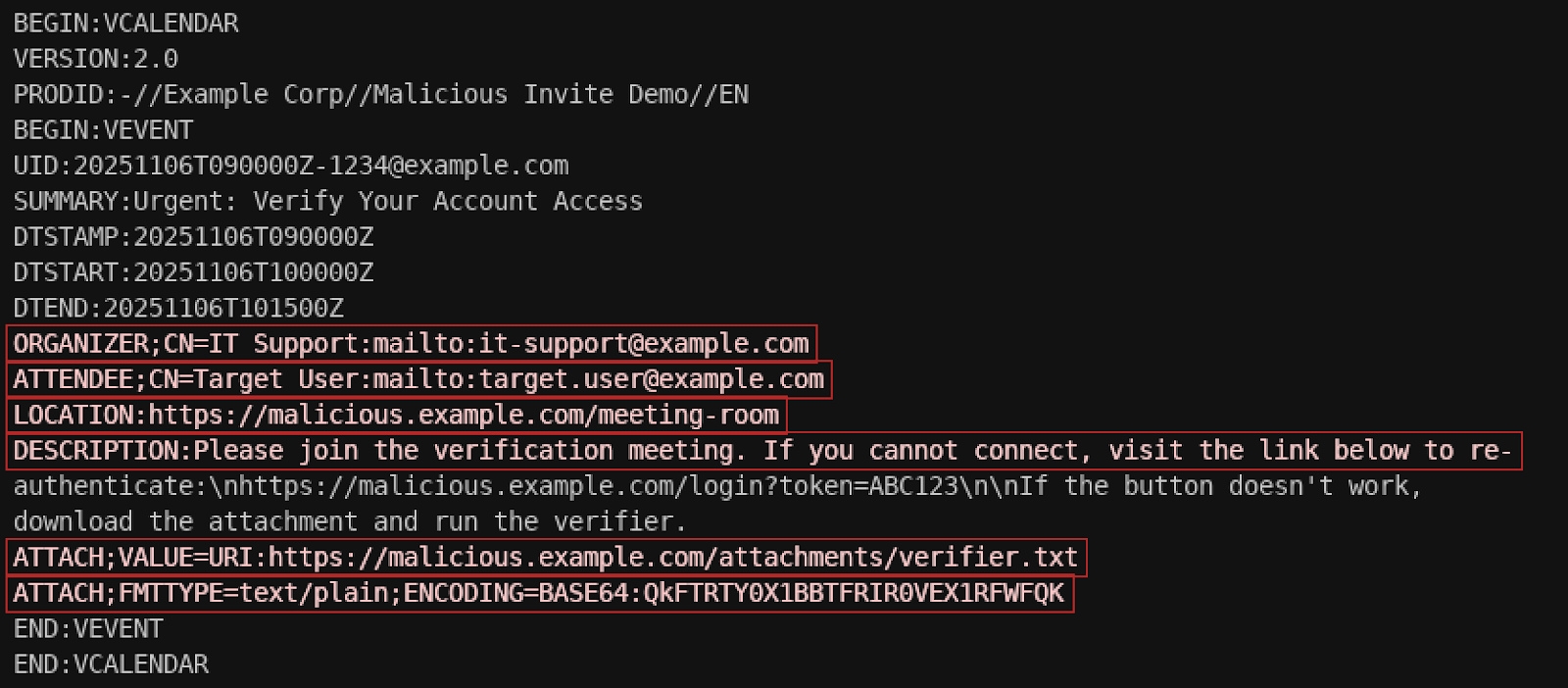A new meeting on your calendar or a new attack vector?
It starts innocently enough. A new meeting appears in your Google calendar and the subject seems ordinary, perhaps even urgent: “Security Update Briefing,” “Your Account Verification Meeting,” or “Important Notice Regarding Benefits.” You assume you missed this invitation in your overloaded email inbox, and click “Yes” to accept.
Unfortunately, calendar invites have become an overlooked delivery mechanism for social engineering and phishing campaigns. Attackers are increasingly abusing the .ics file format, a universally trusted, text-based standard to embed malicious links, redirect victims to fake meeting pages, or seed events directly into users’ calendars without interaction.
Because calendar files often bypass traditional email and attachment defenses, they offer a low-friction attack path into corporate environments.
Defenders should treat .ics files as active content, tighten client defaults, and raise awareness that even legitimate-looking calendar invites can carry hidden risk.
The underestimated threat of .ics files
The iCalendar (.ics) format is one of those technologies we all rely on without thinking. It’s text-based, universally supported, and designed for interoperability between Outlook, Google Calendar, Apple, and countless other clients.
Each invite contains a structured list of fields like SUMMARY, LOCATION, DESCRIPTION, and ATTACH. Within these, attackers have found an opportunity: they can embed URLs, malicious redirects, or even base64-encoded content. The result is a file that appears completely legitimate to a calendar client, yet quietly delivers the attacker’s message, link, or payload.
Because calendar files are plain text, they easily slip through traditional security controls. Most email gateways and endpoint filters don’t treat .ics files with the same scrutiny as executables or macros. And since users expect to receive meeting invites, often from outside their organization, it’s an ideal format for social engineering.
How threat actors abuse the invite
Over the past year, researchers have observed a rise in campaigns abusing calendar invites to phish credentials, deliver malware, or trick users into joining fake meetings. These attacks often look mundane but rely on subtle manipulation:
The lure: A professional-looking meeting name and sender, sometimes spoofed from a legitimate organization.
The link: A URL hidden in the DESCRIPTION or LOCATION field, often pointing to a fake login page or document-sharing site.
The timing: Invites scheduled within minutes, creating urgency (“Your access expires in 15 minutes — join now”).
The automation: Calendar clients that automatically add external invites, ensuring the trap appears directly in the user’s daily schedule.
⠀

Example of where some of the malicious components would reside in the .ics file
⠀
It’s clever, low-effort social engineering leveraging trust in a system built for collaboration.
The “invisible click” problem
The real danger of malicious calendar invites isn’t just the link inside, it’s the automatic delivery mechanism. In certain configurations, Outlook and Google Calendar will automatically process .ics attachments and create tentative events, even if the user never opens or even receives the email. That means the malicious link is now part of the user’s trusted interface with their calendar.
This bypasses the usual cognitive warning signs. The email might look suspicious, but the event reminder popping up later? That feels like part of your day. It’s phishing that moves in quietly and waits.
Why traditional defenses miss it
Security tooling has historically focused on attachments that execute code or scripts. By contrast, .ics files are plain text and standards-based, so they don’t inherently appear dangerous. Many detection engines ignore or minimally parse them.
Attackers exploit that gap. They rely on the fact that few organizations monitor for BEGIN:VCALENDAR content or inspect calendar metadata for embedded URLs. Once delivered, the file can bypass filters, land in the user’s calendar, and lead to a high-confidence click.
What defenders can do now
Defending against calendar-based attacks begins with recognizing that these are not edge cases anymore. They’re a natural evolution of phishing where user convenience becomes the delivery mechanism.
Here are a few pragmatic steps every organization should consider:
Treat .ics files like active content. Configure email filters and attachment scanners to inspect calendar files for URLs, base64-encoded data, or ATTACH fields.
Review calendar client defaults. Disable automatic addition of external events when possible, or flag external organizers with clear warnings.
Sanitize incoming invites. Content disarm and reconstruction (CDR) tools can strip out or neutralize dangerous links embedded in calendar fields.
Raise awareness among users. Train employees to verify unexpected invites — especially those urging immediate action or containing meeting links they didn’t anticipate. Employees can also follow the helpful advice in this Google Support article.
Use strong identity protection. Multi-factor authentication and conditional access policies mitigate the impact if a phishing link successfully steals credentials.
These steps don’t eliminate the threat, but they significantly increase friction for attackers and their malware.
A quiet evolution in social engineering campaigns
Malicious calendar invites represent a subtle yet telling shift in attacker behavior: blending into legitimate business processes rather than breaking them. In the same way that invoice-themed phishing emails once exploited trust in accounting workflows, .ics abuse leverages the quiet reliability of collaboration tools.
As organizations continue to integrate calendars with chat, cloud storage, and video platforms, the attack surface will only expand. Links inside invites will lead to files in shared drives, authentication requests, and embedded meeting credentials. These are all opportunities for exploitation.
Rethinking trust in everyday workflows
Defenders often focus on the extraordinary like zero days, ransomware binaries, and new exploits. Yet the most effective attacks remain the simplest: exploiting human trust in ordinary digital habits. A calendar invite feels harmless and that’s exactly why it works.
The next time an unexpected meeting appears in your calendar, it might be more than just a double-booking. It could be a reminder that security isn’t only about blocking malware, but about questioning what we assume to be safe.
- Labs
- Phishing
- Social Engineering